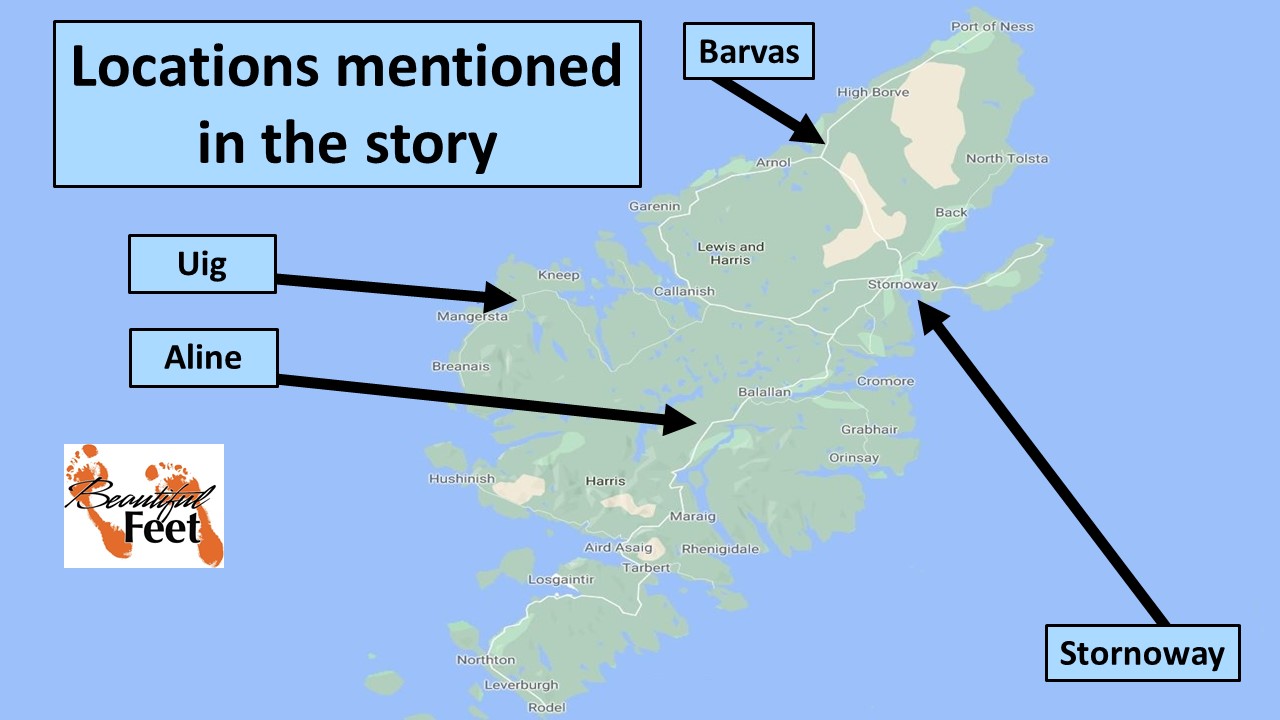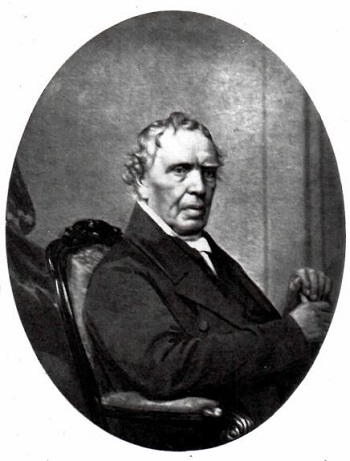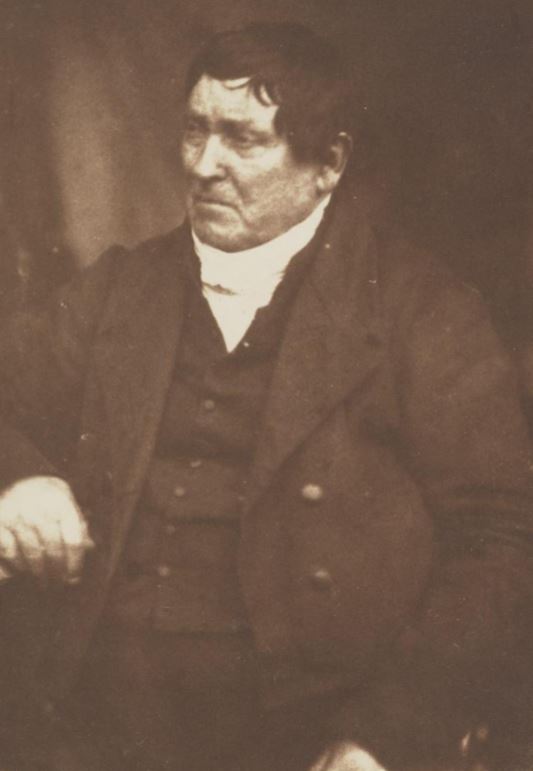

Introduction
This revival’s foundation was laid through the literacy work of Gaelic school societies, beginning in 1811. The purpose of these schools was to teach Gaelic speakers to read the scriptures in their own language. By 1815 there were 8 schools in operation, and by 1833, there were 15, with all these schools having only one textbook—the Bible.
As literacy on the island of Lewis increased through the work of the Gaelic schools, popular evangelical literature also began to circulate.

Extraordinary Prayer
Leading up to the main thrust of the revival, Alexander Macleod, upon taking over his new assignment as the minister of the church in Uig, in April of 1824, set up prayer meetings, and within 14 months people were flocking to his church services from all over the island of Lewis.
During this revival people could be found at all hours of the evening, from 8pm till 1am, praying alone or in small groups in the open-air.
One ship’s captain, during his visit to the port at Stornoway, said he found men praying together, and with many other impressions made upon him, he wrote,
One hears of religion elsewhere, but one sees it here in everything.
Revival at Barvas
A revival on the island of Lewis began in the village of Barvas in 1822, when a young girl, who had been attending a Gaelic school, read one of her lessons from the Bible to her sick mother.
The lesson was from the story of Jesus’ crucifixion. Upon hearing the story, the mother began to weep. The girl thought her mother’s weeping was due to her sickness, so she ran to get help from a neighbor. When the neighbor understood from the mother that her distress was due to conviction of sin from having heard the story of Jesus’ crucifixion, this neighbor asked for the story to be read to her. After having heard the story, she too was overcome with conviction of sin, followed by weeping.
When the girl’s father came home from work, and learned of what had transpired, he asked for the story to be read to him, with the story having the same effect on him. The young lady then went from village to village reading the story until a “great number” had turned to Jesus.

Island of Lewis / Harris
Gaelic Teachers/ Evangelists
Some of the teachers in the Gaelic schools began conducting open-air services, a direct violation of the Gaelic School Society’s rules. One such teacher was John Macleod, and though he was dismissed by the Society due to his violation, he continued his preaching, drawing large crowds.
The moderate/ liberal ministers of the day were greatly offended, and undoubtedly jealous of the attention Macleod and other itinerant ministers were receiving. They attacked the “unauthorized” preaching and claimed that the “fanatics” were destroying order in the communities. They specifically stated that the preaching led to “emotional frenzy,” “insanity,” “convulsive fits,” “mental derangement,” “suicide,” “domestic violence and despair,” all the results of “religious mania.” Regardless of the attacks, it was noted that from these itinerant ministers there was much fruit, with converts being “steadfast, godly Christians.”
Another of the evangelists during this revival was the Uig native Malcom MacRitchie. This young man was converted in 1818, at the age of 14. MacRitchie had attended one of the Gaelic literacy schools, and in 1820, upon hearing that Bibles could be purchased in Stornoway, located 20 miles away, he set out on the 40-mile roundtrip journey by foot to make the purchase. Upon his arrival in Stornoway he discovered he didn’t have enough money to obtain the Bible, and he had to return home to get additional finances. He then traveled back to Stornoway, again by foot, and obtained his much sought-after possession.
With MacRitchie now having a Bible, he began conducting readings in his home for neighbors. The local minister, offended and jealous of the crowds that were gathering to listen to the readings, said that it was nothing more than a sign of delusion.
At the age of 20 (1823), MacRitchie began teaching at Aline. Crowds of all ages would gather at the school, both day and night, to hear MacRitchie speak, and the results were many conversions. MacRitchie eventually began itinerating throughout the islands of Lewis, Harris, Skye, and even to areas where there were no churches, obtaining tremendous evangelistic success.
Angus McIver, also from Uig, was converted during the revival there, and he gave the movement a boost in the late 1820s when he went to Ardnamurchan as a teacher with the Gaelic School Society. People flocked to his classes in their hunger to read the Word of God. There were many people who were powerfully influenced through his ministry.

Island of Lewis and Harris, with Harris highlighted in red
Physical Manifestations
As the revival spread, meetings for prayer and preaching emerged in different locations. These meetings were often accompanied with physical prostrations, trembling, and even trances, some lasting over 24 hours. Visions were said to have been of heaven and hell.
The physical manifestations, which some professed to be the presence of God, caused the year 1822 to become commonly known as “The year of swoonings.”

Alexander Macleod
Stability and Recognition Given to the Revival
On April 28, 1824, Alexander Macleod (1786-1869) received an assignment to become the minister in Uig. He was the first evangelical minister to receive such an appointment.
Prior to his arrival the initial stages of the revival were in the hands of itinerant lay-ministers or Gaelic language teachers. It was in the services led by these individuals that the revival became discredited by ministers of area churches. The denunciations leveled at the revival were due to what was classified as emotional “excesses” and “enthusiasm,” or “religious delusions.” Most of these discrediting attacks came to an end as Macleod came onto the scene and brought biblical balance to the movement.
Prior to Macleod’s arrival in Uig, illiteracy and superstition were widespread. There was practically no one that understood basic Bible doctrines, not even elders of the church. The custom of honoring the Lord’s Day was not kept, and whiskey and tobacco were sold outside the church throughout the week, even on Sundays. Even with these prevailing conditions, according to custom, when people became of age, they joined the church.
With 800-1,000 being on the Uig church membership list, Macleod cancelled the annual, several-day communion season (better understood today as a camp-meeting—which culminated in a communion service). It was during this annual event that communion was offered to qualified church members only. With ignorance being rife in this congregation, Macleod canceled the communion event for three years due to no one being qualified to partake. His actions were initially much maligned, but the effort paid off over time.
To bring his congregation to a state of “being qualified” to partake of communion, he began setting up prayer and teaching meetings in different locations. He also initiated systematic visitation at parishioners’ homes to conduct thorough follow-up. Following these initial efforts, within just 14 months after he took over the church, people were flocking to his meetings from all over Lewis, and Uig remained the center of the revival. Macleod commented on that occasion:
Many young and old are in tears every Lord’s Day, and several are so affected as not to be able to contain themselves or to retire.
Deep conviction of sin began to spread and Macleod wrote that the work of the Lord had a spreading effect:
They now come to me from every corner, crying, “What shall we do to be saved?”
Communion Scheduled
Macleod scheduled his first communion service on the 25th of June 1827, and not less than 7,000 were gathered for this several-day event.
With the church conducting a closed communion, those approved to partake of the elements were given tokens (like coins) ahead of time, which they were to present upon their approach to the Lord’s Table.
Before Macleod’s arrival in Uig there were close to 1,000 that were approved to receive communion, but now the number had dwindled to 20, and still when communion was offered on June 25, only 6 came forward, as the remainder felt unworthy to partake. The conviction of sin following Macleod’s teaching was having a significant impact on the people.
The enormous decrease in numbers from those who had partaken during the Lord’s Supper in previous years did not have a negative effect on the work of God. During this event there was the awareness of God convicting and impressing on all present His divine presence.
When the elements were given, on June 25th, Macleod wrote that “there appeared a shower of revival from the presence of the Lord through the whole congregation.” He said that it was a “night to be remembered,” as there was “pungent conviction” that fell upon some for not having prepared themselves for communion.
The entire evening was spent by those present praying privately or in groups. Often these groups were displaying unusual instances of joy, and at other times, sorrow. Those still unrepentant were under severe conviction of sin and felt greatly ashamed. On Monday, as the several-day communion season continued, many felt disappointed that they had not prepared themselves for the Lord’s Table.

“Apostle of the North”: John Macdonald
During this communion event a sermon was preached by a visiting minister, John Macdonald. The account of his sermon went like this.
On the following day the Doctor preached again; and he preached with the Holy Ghost sent down from heaven. The great congregation was smitten as by a mighty wind and the people were laid prostrate on the earth. There were loud outcries. To secure order the Doctor interrupted his sermon and gave out a few verses to sing.
Those leading the songs were Malcolm MacRitchie and Angus MacIver.
They sang; but the congregation were overcome with silence. Dr Macdonald stood behind them singing, and it is said that in the congregation of many thousands these were the only voices to be heard.
1828 Communion Season
During the communion season at Uig the following year, there were over 9,000 that had assembled from all over the island, and “the spirit of prayer and supplication had fallen upon the people.” It was during this time that a widow, by the name of Mackenzie, stated that:
The hillsides and moors were literally covered with people pleading for mercy on their own souls and the souls of their neighbours.
Results of the Revival
► The Uig revival on the island of Lewis spread throughout most of the island by 1840.
► At the beginning of the revival there was illiteracy and superstition, and following the revival, in 1840, Donald Sage wrote that across the island of Lewis,
God is well known; the gospel is not only understood, but ardently sought after… and [Lewis] has become one of the most enlightened parts of Christian Scotland.
► Tremendous gratitude was expressed toward the Gaelic school societies, with one man uttering these words:
Blessed God! Blessed Bible! Blessed people that sent these schools! Blessed schools that teach the Bible of God to perishing sinners! Blessed teachers, men of Christ! I thought “what would my poor country be, but for the Bible and these schools.”
Sources
► Angus MacIver by Hebridean Connections
► Diary and Sermons of the Rev. Alexander Macleod by Rev. D. Beaton, Wick
► Disruption Worthies of the Highlands by John Grant
► Gaelic School Society by the Colonial Times, Tuesday, February 22, 1842
► John Macleod by Hebridean Connections
► Land of Many Revivals by Tom Lennie
► Narratives of Revivals of Religion in Scotland, Ireland, and Wales by Anonymous
► Outer Hebrides Revivals/ Island of Lewis, 1824-1835 by UK Wells
► Parish Life in the North of Scotland by Rev. Donald Sage
► Rev Alexander Macleod by Hebridean Connections
► Society for Promoting Christian Knowledge by Wikipedia
► The Apostle of the North by Rev. John Kennedy
Return to List of Revival Stories
Chet & Phyllis Swearingen:
Office: (260) 920-8248
romans1015@outlook.com
Beautiful Feet
P.O. Box 915
Auburn, IN 46706

